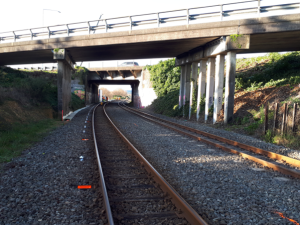Vitruvius has recently been supporting Fulton Hogan with track and structure monitoring during the construction of the Drury Rail Over bridge project. The project will deliver new bridges on State Highway 1 for Waka Kotahi as part of the Papakura to Pukekohe Rail Electrification programme
Track monitoring was a requirement of KiwiRail, the rail corridor owner, to ensure no effect on the rail infrastructure and safe railway operation during the construction project.
The time frame to procure and instal the monitoring system was very tight and Vitruvius worked closely with its supplier and KiwiRail to procure the system and gain additional access to install the system on time to support the Fulton Hogan critical path programme. Vitruvius proposed a Micro Electro-Mechanical (MEM) System in preference to one based on optical devices due to cost, reliability, safety and site constraints as well as its proven use in a rail environments overseas (United Kingdom and Australia) and here in New Zealand (through a previous Vitruvius project).
The scope was to establish a real time monitoring regime protecting 160m of track on the North Island Main Trunk (NIMT) up main. The system had to be capable of automatic reporting with a data cycling frequency of 15 mins. Vitruvius were also asked to extend the monitoring system to the bridge structures.
During a recent block of line Vitruvius successfully installed 82 MEMs tilt sensors on sleepers on the NIMT up main and 10 structure mounted sensors on the rail overbridges.
The track mounted sensors were baselined over several weeks and now provide near real time track cant and twist monitoring data which along with tilt monitoring of the structures has allowed Fulton Hogan to progress with its pilling works.
The data recorded by the sensors is transmitted from the site to a cloud server where it can be viewed by stakeholders. Alerts are triggered when movement thresholds are reached and are transmitted by email and SMS to selected project staff.
Vitruvius were pleased to be asked to support a principal contractor with this unique requirement of a major infrastructure project and once again use an innovative technology to do so to enhance cost and safety outcomes.

